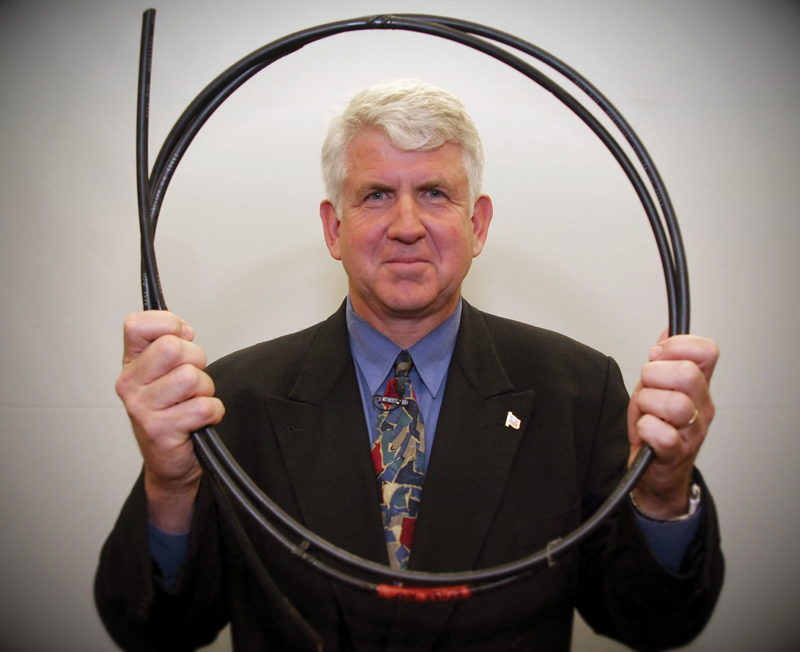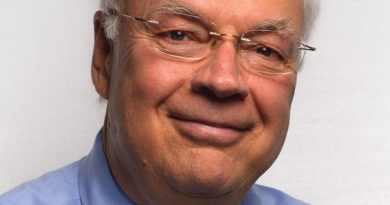Exclusive Interview – Bob Metcalfe The Father of Ethernet
The father of Ethernet is big on broadband, optimistic about connectivity and excited about a wellspring of “serendipitous” new apps that will be developed for the emerging giganet world.
By Stewart Schley
![]()
When a 27-year old, red-bearded, infinitely curious MIT protégé named Bob Metcalfe joined the research team at Xerox’s legendary Palo Alto Research Center (PARC) in 1972, he had his first encounter with an emerging curiosity: the personal computer
Developed by a team of computer scientists including Alan Kay, Butler Lampson and Chuck Thacker, these new-to-the-world workstations harnessed computing power associated with the hulking mainframes of the day and deposited it into a form factor that could rest on a desktop. But as intrigued as he was by the promise of personalized computing, Metcalfe and his colleagues at PARC were quick to realize the revolution would fall flat if these devices couldn’t talk to each another. Data would remain trapped inside isolated boxes, expensive printers would be tethered to single machines, and there would be no way to coax even the simplest of electronic messages onto somebody else’s screen.
Metcalfe’s solution was blocked out in a 12-page memo dated May 22, 1973. It described a mechanism for joining multiple computers over a coaxial cable network and giving them rules to work by. What Metcalfe originally named “The Ether Network” eventually would become known to the world as Ethernet, a set of computer networking technologies that ultimately would play a big role in the cable industry’s own technology and product transformation.
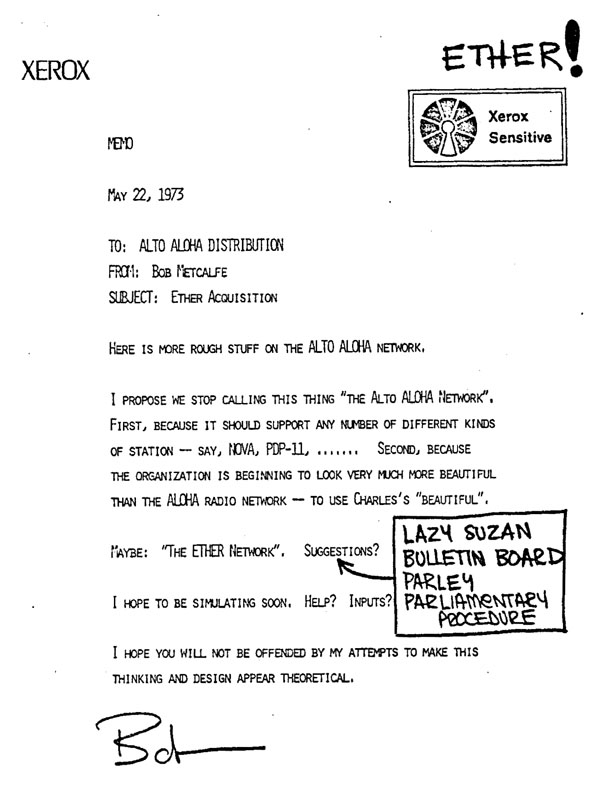 |
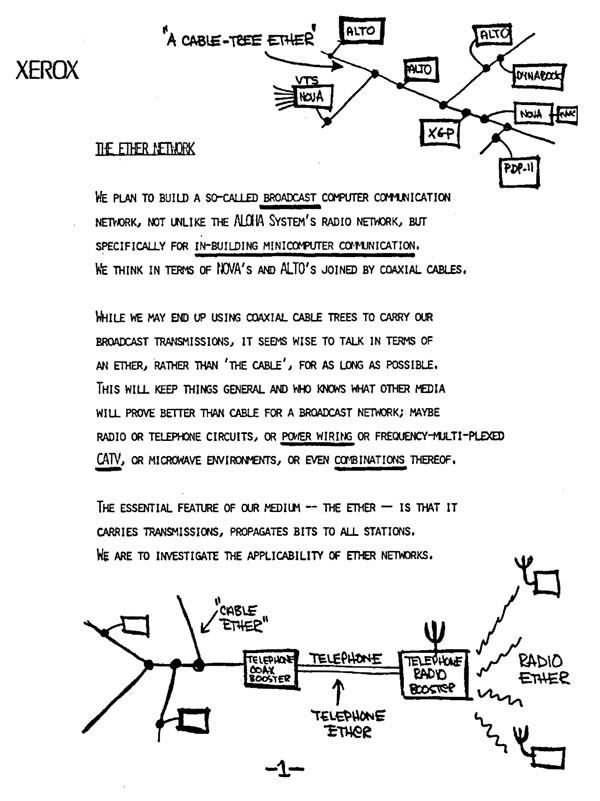 |
A memo Metcalfe authored in 1973 established the basic principles for Ethernet.
Metcalfe and his team established the first experimental Ethernet specification for local area networking in 1973. Operating over a coaxial cable bus, it conveyed data at a rate of 2.94 Mbps. Ten years later, with its prescribed speed having accelerated to 10 Mbps, Ethernet was affirmed as the IEEE 802.3 global standard. Its familiar twisted-pair cables, latching connectors and rectangular ports would become instrumental components of the cable industry’s march into high-speed Internet delivery, embedded into millions of cable modems that were building blocks of the industry’s consumer broadband revolution.
![]()
Interview with the Inventor
Forty-five years after that defining memo was circulated, we spoke with Metcalfe, now (along with his wife) a professor at the University of Texas in Austin, where the couple resides nine months of the year. From his summer home in the fishing village of Owls Head, Maine, Metcalfe recounted memories of Ethernet’s early history and offered a vision for the broadband-powered future.
If there’s an elevator pitch for why Ethernet matters, what is it?
The role Ethernet played was to accelerate a network-centric view of the world.
In 1973 did you even imagine applications like streaming video might one day emerge?
Not only did we not anticipate video, we believed voice would be impossible, because the packets we were storing and forwarding were asynchronous. But one of the principal characteristics of the Ethernet model was, ‘build it and they will come.’ Another was that it promulgated the idea that you wanted to go as fast as you could. The first Ethernet was 2.94 megabits per second, and apps emerged. Now, we’re doing it again. We’re building gigabit networks, and what that will inspire are these serendipitous applications that will only come with a gigabit world, not the megabit world.
You started the networking products company 3Com when you were still in your twenties. If you were that age today, what would you be doing?
Within the context of broadband, I would probably be doing biological/genetic computing…or I’d be working on augmented reality. In broadband, there are a lot of opportunities.
What makes you optimistic?
It’s sort of the generalized belief that connectivity is good. Democracy is spreading, people are becoming more prosperous. The most important new fact about the human condition is that we are connected. We’ve gone from roads and mail and the telegraph and the telephone, to radio and television, to the kilobit Internet and now the megabit Internet, to the forthcoming augmented, mobile gigabit Internet of things. We are connected. This is a qualitatively new fact. And the belief here is that being connected is good for us; that democracy flourishes and tyranny is defeated, that frictions to prosperity are reduced.
There are challenges, though.
It’s always true that when a new technology and a new opportunity arises, we don’t know what to do with it. The standard example is the arrival of television: The first thing we did with it was to point the camera at a stage and have actors act on it.
But all the people who advocate for — for example — going off Twitter because of horrible things that are said, they’re wrong. Twitter and Facebook, even though they haven’t quite worked everything out yet, even though they still don’t know how to manage all that connectivity, we’ve still got it and it’s a good thing. So this would be a good area to work in: How should our use of connectivity be structured to enhance its positive impact? Junk news is a bad thing, bullying is a bad thing, spam is a bad thing. There’s a long list of bad things that happen when you connect people. So how do you structure your connectivity relationship with the world so that it’s less of a bad thing and more of a good thing? That is a cool thing to work on. I’m optimistic it will all get better. Will it be perfect? Never. But it will be better. Entrepreneurs are optimistic, or else we wouldn’t be entrepreneurs.
Metcalfe’s Law is a well-known axiom that explains, essentially, how the value of networks increases as the number of connected users grows. What’s it like to have a law named after you?
I’m used to it now. It was named after me in 1995 by (the author and futurist) George Gilder, but it was actually first applied in 1982 at 3Com, in a slide presentation. So I’ve had a long time to get used to it, and I’ve been having fun with it since 1995. I say ‘fun’ because there’s a whole community of mathematicians and scientists who want to quibble over the exponents. They’ve missed the whole point: that it’s a vision. But I’m not backing down. I wrote a paper for IEEE in December of 2015 that applied Metcalfe’s Law to the first 10 years of Facebook. I was able to fit — and fit is the operative word — the quadratic model to revenues and monthly average users at Facebook.
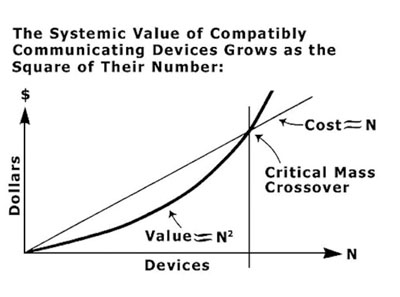
So Metcalfe’s Law is less about an exact mathematical formula and more about…?
It’s a vision. In a way it goes back to optimism about connectivity. When you connect things together, the value rises really fast because of all the possible connections that can be made, and the friction that’s reduced, and the collaboration that’s enhanced. So it’s good to bet on connectivity.
What’s your personal experience today with broadband?
I have an iPhone that receives LTE. We have a cable broadband system in our house that gets us Internet access and Wi-Fi. And right now we’re speaking over an application called AT&T Wi-Fi Calling. My iPhone is running software that creates an AT&T telephone call out of the Wi-Fi running over the cable TV system.
You’ve long been a champion of a hands-off regulatory approach to broadband. Why?
There are two kinds of people. We all agree connectivity is a good thing, but there are people who believe the marketplace is highly defective; that there’s a lack of choice everywhere and what we need is for the FCC to regulate the Internet. I’m not one of them. I tend to think our competitive system has worked wonderfully over the last 50 years. In Austin, where I live half the year, Google showed up with Google Fiber, and we immediately had AT&T, Time Warner Cable and Google Fiber, plus two other companies I’d never even heard of.
Network neutrality regulation: bad idea?
Network neutrality is a very bad idea. And I’ve warned Google about this. The danger there is you’re inviting the government to regulate the bandwidth they use for their services. So after we have ‘net neutrality,’ then we might have ‘advertising neutrality’ whereby somebody says, ‘Gee, it’s really unfair for Google to have such a monopoly in advertising.’ I don’t think they understand how that works.
How was the vibe and culture of Silicon Valley different in the 1979, when you started 3Com?
The biggest difference is scale. The Silicon Valley I was in was nerds selling to nerds. And there were only 11 of us.
The companies were smaller then — no billion-dollar “unicorns” — but also the focus was different.
The Silicon Valley of today serves consumer markets in the billions. We didn’t have unicorns back in my day. The markets were too small and technology hadn’t really caught on the way it has now. So there was a difference in scale. And that changes the kind of people who become involved. The Silicon Valley I was in was very engineering-oriented. Whereas today it’s much more marketing-oriented. Also, there was nothing in the Silicon Valley I was in that smacked of evil or corruption. Today we hear things like the Uber story — half of which I think is made up — but there’s still a nastiness there that I don’t remember.
By 1999 the company you founded and later exited was doing close to $6 billion in revenue and had a market cap of $34 billion. How do you think about that time in your life?
Fabulous experience. But very hard. Lots of learning. We were running a company, creating products, growing markets, recruiting people. It was hard work.
What did it teach you?
One of the basics I learned — this metaphor only works for people who know how to drive a car with a manual transmission — is that when you’re in a high-performance, rapidly growing company you’re constantly shifting gears. People redline. You put them in a position, the company outgrows them, they redline and you have to shift. It’s pretty brutal sometimes, when you have to let people go or reassign them or tell them they’re not able anymore to do a job that they’d succeeded at. That’s one of the many lessons of building a company and growing it.
But it sounds like you loved it.
It was extraordinary fun. It’s what I miss. I spent 10 years as a venture capitalist, and I’d go to the board meetings but they wouldn’t let me go to work for the rest of the day. I had to leave. They said, ‘Bob, the board meeting’s over, you have to go now.’ I miss the team building and the camaraderie and the rah-rah of building a company.
 You were (and maybe still are) an accomplished tennis player in/around the New England circuit. Do you see any parallels between the game and the tech business?
You were (and maybe still are) an accomplished tennis player in/around the New England circuit. Do you see any parallels between the game and the tech business?
I was captain of my college team; in 1969 we had a record of 15-4. I was ranked No. 4 or 5 on the team. Then I played New England amateur tennis for several years, and then I stopped, pretty much. But being a competitive amateur was a huge learning experience. I’ve often thought about writing a book about what tennis taught me about success. The ball goes down: How do you react? What’s your strategy? When you miss a shot or you hit the net, some players will smash their racket against the pole, storm around, yell a lot. I try to recover from the mistake, as opposed to making it worse. And that applies to business. You make a mistake, try to figure out what you did wrong and make an adjustment.
Finally: For several years you and your wife raised rare pigs and other animals on a farm in Maine. What did they teach you?
It was more what they taught my kids. We had sheep and pigs and a llama and a donkey. One thing we didn’t have to do was explain sex to our children.
![]()
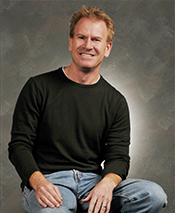 About the Interviewer
About the Interviewer
Stewart Schley,
Media/Telecom Industry Analyst
stewart@stewartschley.com
Meet Stewart Schley, a journalist who is no stranger to broadband. For over 20 years Stewart has been captivating readers with his industry foresight and knowledge. He has a special talent for providing the best business profiles by sitting down… one on one… with his subject and getting the real story. If you missed his compelling interviews with John Malone, JR Walden or Peter Schultz, check them out at broadbandlibrary.com in the archives section.
Special thanks to Jeff Finkelstein, Executive Director of Advanced Technology at Cox Communications, for his assistance with the interview.
Image provided courtesy of Palo Alto Research Center, a Xerox company.
Shutterstock.com

